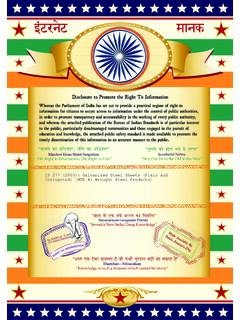Transcription of Keenan Crane Last updated: February 25, 2021
1 D ISCRETE D IFFERENTIAL G EOMETRY: A N A PPLIED I NTRODUCTION. Keenan Crane Last updated: February 25, 2021. Contents Chapter 1. Introduction 3. Disclaimer 6. Copyright 6. Acknowledgements 6. Chapter 2. Combinatorial Surfaces 7. Abstract Simplicial Complex 8. Anatomy of a Simplicial Complex: Star, Closure, and Link 10. Simplicial Surfaces 14. Adjacency Matrices 16. Halfedge Mesh 17. Written Exercises 21. Coding Exercises 26. Chapter 3. A Quick and Dirty Introduction to Differential Geometry 28. The Geometry of Surfaces 28. Derivatives and Tangent Vectors 31. The Geometry of Curves 34. Curvature of Surfaces 37. Geometry in Coordinates 41. Chapter 4. A Quick and Dirty Introduction to Exterior Calculus 45. Exterior Algebra 46. Examples of Wedge and Star in Rn 52. Vectors and 1-Forms 54. Differential Forms and the Wedge Product 58. Hodge Duality 62. Differential Operators 67. Integration and Stokes' Theorem 73. Discrete Exterior Calculus 77. Chapter 5. Curvature of Discrete Surfaces 84.
2 Vector Area 84. Area Gradient 87. Volume Gradient 89. Other Definitions 91. Gauss-Bonnet 94. Numerical Tests and Convergence 95. Chapter 6. The Laplacian 100. Basic Properties 100. Discretization via FEM 103. Discretization via DEC 107. 1. CONTENTS 2. Meshes and Matrices 110. The Poisson Equation 112. Implicit Mean Curvature Flow 113. Chapter 7. Surface Parameterization 116. Conformal Structure 118. The Cauchy-Riemann Equation 119. Differential Forms on a Riemann Surface 120. Conformal Parameterization 122. Eigenvectors, Eigenvalues, and Optimization 126. Chapter 8. Vector Field Decomposition and Design 133. Hodge Decomposition 134. Homology Generators and Harmonic Bases 141. Connections and Parallel Transport 146. Vector Field Design 153. Chapter 9. Conclusion 157. Bibliography 158. Appendix A. Derivatives of Geometric Quantities 160. List of Derivatives 164. CHAPTER 1. Introduction 4. 4 3. 3 5. 5. 2 1 2. 1. These notes focus on three-dimensional geometry processing, while simultaneously providing a first course in traditional differential geometry.
3 Our main goal is to show how fundamental geometric concepts (like curvature) can be understood from complementary computational and mathematical points of view. This dual perspective enriches understanding on both sides, and leads to the development of practical algorithms for working with real-world geometric data. Along the way we will revisit important ideas from calculus and linear algebra, putting a strong emphasis on intuitive, visual understanding that complements the more traditional formal, algebraic treatment. The course provides essential mathematical background as well as a large array of real-world examples and applications. It also provides a short survey of recent developments in digital geometry processing and discrete differential geometry. Topics include: curves and surfaces, curvature, connections and parallel transport, exterior algebra, exterior calculus, Stokes' theorem, simplicial homology, de Rham cohomology, Helmholtz-Hodge decomposition, conformal mapping, finite element methods, and numerical linear algebra.
4 Applications include: approximation of curvature, curve and surface smoothing, surface parameterization, vector field design, and computation of geodesic distance. One goal of these notes is to provide an introduction to working with real-world geometric data, expressed in the language of discrete exterior calculus (DEC). DEC is a simple, flexible, and efficient framework which provides a unified platform for geometry processing. The notes provide essential mathematical background as well as a large array of real-world examples, with an emphasis on applications and implementation. The material should be accessible to anyone with some exposure to basic linear algebra and vector calculus, though most of the key concepts are reviewed as needed. Coding exercises depend on a basic knowledge of either Javascript or C++, though knowledge of any programming language is likely sufficient: we do not make heavy use of paradigms like inheritance, templates, etc. The notes also provide guided written exercises that can be used to deepen understanding of the material.
5 3. 1. INTRODUCTION 4. Why use exterior calculus? There are, after all, many other ways to describe algorithms for mesh processing. One reason has to do with language: the exterior calculus of differential forms is, to a large degree, the modern language of differential geometry and mathematical physics. By learning to speak this language we can draw on a wealth of existing knowledge to develop new algorithms, and better understand current algorithms in terms of a well-developed theory. It also allows us to easily write down and implement many seemingly disparate algorithms in a single, unified framework. In these notes, for instance, we'll see how a large number of basic geometry processing tasks (smoothing, parameterization, vector field design, etc.) can be expressed in only a few lines of code, typically by solving a simple Poisson equation. There is another good reason for taking this approach, beyond simply saying the same thing in a different way. By first formulating algorithms in the smooth geometric setting, we can ensure that essential structures are subsequently preserved at the discrete level.
6 As one elementary example, consider the vertex depicted above. If we take the sum of the tip angles i , we get a number that is (in general) different from 2 . On any smooth surface, however, we expect this number to be exactly 2 said in a differential-geometric way: the tangent space at any point should consist of a whole circle of directions. Of course, if we consider finer and finer approximations of a smooth surface by a triangle mesh, the vertex will eventually flatten out and our angle sum will indeed approach 2 as expected. But there is an attractive alternative even at the coarse level: we can redefine the meaning of angle so that it always yields the expected result. In particular, let 2 . s :=. i i be the ratio between the angle sum 2 that we anticipate in the smooth setting, and the Euclidean angle sum i i exhibited by our finite mesh, and consider the augmented angles i := s i . In other words, we simply normalize the usual Euclidean angles such that they sum to exactly 2 , no matter how coarse our mesh is: i = s i = 2.
7 I i From here we can carry out all the rest of our calculations as usual, using the augmented or discrete angles i rather than the usual Euclidean angles i . Conceptually, we can imagine that each vertex has been smoothed out slightly, effectively pushing the curvature of our surface into otherwise flat triangles. This particular convention may not always (or even often) be useful, but in problems where the tangent space structure of a surface is critical it leads to highly effective algorithms for mesh processing (see for example [KCPS13, SC18]). This message is one theme we'll encounter frequently in these notes: there is no one right way to discretize a given geometric quantity, but rather many different ways, each suited to a particular purpose. The hope, then, is that one can discretize a whole theory such that all the pieces fit together nicely. DEC is one such theory, which has proven to be highly successful at preserving the homological structure of a surface, as we'll discuss in Chapter 8.
8 The remainder of these notes proceeds as follows. We first give an overview of the differential geometry of surfaces (Chapter 3), using a description that leads naturally into a discussion of smooth exterior calculus (Chapter 4) and its discretization via DEC. We then study some basic properties of discrete surfaces (Chapter 2) and their normals (Chapter 5), leading up to an equation that is central to our applications: the discrete Poisson equation (Chapter 6). The remaining chapters investigate various geometry processing applications, introducing essential geometric concepts 1. INTRODUCTION 5. along the way (conformal structure, homology, parallel transport, etc.). Coding exercises refer to a supplementary C++ framework, available from which includes basic mesh data structures, linear algebra libraries, and visualization tools any similar framework or library would be suitable for completing these exercises. Solutions to written exercises are available upon request.
9 Our goal throughout these notes was to describe every concept in terms of a concrete geometric picture we have tried as much as possible to avoid abstract algebraic arguments. Likewise, to get the most out of the written exercises one should try to make an intuitive geometric argument first, and only later fill in the formal details. ACKNOWLEDGEMENTS 6. Disclaimer ACHTUNG! These notes are very much a work in progress and there will be errors. As always, your brain is the best tool for determining whether a statement is actually true! If you encounter errors please don't hesitate to contact the author, noting the page number and the version of the notes. Copyright Images were produced solely by the author with the exception of the Stanford Bunny mesh, which is provided courtesy of the Stanford Graphics Computer Laboratory. Text in this document was the sole creation of its author. c Keenan Crane 2011 2021, all rights reserved. Acknowledgements These notes grew out of a course on discrete differential geometry (DDG) taught annually starting in 2011, first at Caltech and now at CMU.
10 Peter Schro der, Max Wardetzky, and Clarisse Weischedel provided invaluable feedback for the first draft of many of these notes; Mathieu Desbrun, Fernando de Goes, Peter Schro der, and Corentin Wallez provided extensive feedback on the SIGGRAPH 2013 revision. Joshua Brakensiek and Mark Gillespie made some nice contributions to written exercises; Nicholas Sharp and Rohan Sawhney helped revolutionize the associated codebase. Thanks to Mark Pauly's group at EPFL for suffering through (very) early versions of these lectures, to Eitan Grinspun for detailed feedback and for helping develop exercises about convergence, and to David Bommes for test-driving the whole thing at Aachen. David Bachman and Katherine Breeden provided a bunch of useful feedback in Spring 2020, during their run of the course at Harvey Mudd College and Pitzer College. Thanks also to those who have pointed out errors over the years: Mirela Ben-Chen, Nina Amenta, Chris Wojtan, Yuliy Schwarzburg, Robert Luo, Andrew Butts, Scott Livingston, Christopher Batty, Howard Cheng, Gilles-Philippe Paille , Jean-Franc ois Gagnon, Nicolas Gallego-Ortiz, Henrique Teles Maia, Joaqu n Ruales, Papoj Thamjaroenporn, Niklas Rieken, Yuxuan Mei, John C.






